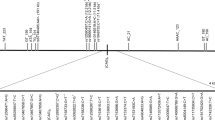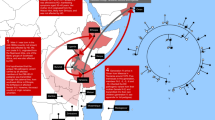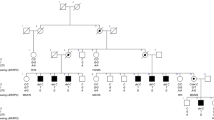Abstract
No detectable rearrangements involving chromosome 4p16.3 have been observed in patients with Huntington's disease (HD). New mutations for HD could involve structural alterations which might aid the localization of the defective gene. We have reinvestigated a well documented sporadic case of HD. DNA haplotyping with markers between D4S10 and the telomeric locus D4S141 reveals a recombination event in one chromosome of the sporadic HD patient. The site of recombination maps within a 50 kilobase (kb) region, about 700 kb from the 4p telomere. Based on the extremely low HD mutation rate and significantly decreased recombination in the distal region of 4p, we hypothesize a direct link between the site of the recombination and HD in this patient.
This is a preview of subscription content, access via your institution
Access options
Subscribe to this journal
Receive 12 print issues and online access
$209.00 per year
only $17.42 per issue
Buy this article
- Purchase on Springer Link
- Instant access to full article PDF
Prices may be subject to local taxes which are calculated during checkout
Similar content being viewed by others
References
Hayden, M.R. Huntington's Chorea (Springer, New York, 1981).
Gusella, J.F. et al. A polymorphic DNA marker genetically linked to Huntington's Disease. Nature 306, 234–238 (1983).
Magenis, R.E. et al. Huntington's Disease-linked restriction fragment length polymorphism localized with band p16.1 of chromosome 4 by in situ hybridization. Am. J. hum. Genet. 39, 383–391 (1986).
Wasmuth, J.J. et al. A highly polymorphic,locus very tightly linked to the Huntingon's disease gene. Nature 332, 734–736 (1988).
MacDonald, M.E. et al. Clustering of multiallele DNA markers near the Huntington's Disease gene. J. clin. Invest. 84, 1013–1015 (1989).
Theilmann, J. et al. Non-random association between alleles detected at D4S95 and D4S98 and the Huntington's disease gene. J. med. Genet. 26, 676–681 (1989).
Snell, R.G. et al. Linkage disequilibrium in Huntington's disease: an improved localisation for the gene. J. med. Genet. 26, 673–675 (1989).
Adam, S.A. et al. Linkage disequilibrium and modification of risk for Huntington disease. Am. J. hum. Genet. 48, 595–603 (1991).
MacDonald, M.E. et al. Complex patterns of linkage disequilibrium in the Huntington disease region. Am. J. hum. Genet. 49, 723–734 (1991).
Andrew, S., Theilmann, J., Hedrick, A., Mah, D., Weber, B. and Hayden, M.R. Nonrandom association between Huntington disease and two loci separated by about 3 Mb on 4p16.3. Genomics 13, 301–311 (1992).
MacDonald, M.E. et al. Recombination events suggest potential sites for the Huntington's disease gene. Neuron 3, 183–190 (1989).
Robbins, C. et al. Evidence from family studies that the gene causing Huntington disease is telomeric to D4S95 and D4S90. Am. J. hum. Genet. 44, 422–425 (1989).
Bates, G.P. et al. Defined physical limits of the Huntington disease gene candidate region. Am. J. hum. Genet. 49, 7–16 (1991).
Whaley, W.L. et al. Mapping of cosmid clones in Huntington's disease region of chromosome 4. Somatic Cell molec. Genet. 17, 83–91 (1991).
Monaco, A.P., Neve, R., Colletti-Feener, C., Bertelson, C.J., Kurnit, D.M. and Kunkel, L.M. Isolation of cDNAs for portions of the Duchenne muscular dystrophy gene. Nature 323, 646–650 (1986).
Cawthon, R. et al. A major segment of the neurofibromatosis type 1 gene: cDNA sequence, genomic structure, and point mutations. Cell 62, 193–201 (1990).
Wallace, M.R. et al. Type 1 neurofibromatosis gene: identification of a large transcript disrupted in three NFI patients. Science 249, 181–186 (1990).
Stevens, D. & Parsonage, M.J. Mutations in Huntington's Chorea. Neurol. Neurosurg. Psychiatry 32, 140–143 (1969).
Wolff, G. et al. New mutation to Huntington's disease. J. med. Genet. 26, 18–27 (1989).
Weber, B., Collins, C., Kowbel, D., Riess, O. & Hayden, M.R. dentification of multiple CpG islands and associated conserved sequences in a candidate region for the Huntington disease gene. Genomics 11, 1113–1124 (1991).
Weber, B. et al. Isolation and characterization of new highly polymorphic DNA markers from the Huntington disease region. Am. J. hum. Genet. 50, 382–393 (1992).
Buetow, K.H. et al. A detailed multipoint map of human chromosome 4 provides evidence for linkage heterogeneity and position-specific recombination rates. Am. J. hum. Genet. 48, 911–925 (1991).
Orita, M., Suzuki, Y., Sekiya, T. & Hayashi, K. Rapid and sensitive detection of point mutations and DNA polymorphisms using the polmerase chain reaction. Genomics 5, 874–879 (1989).
Magni, G.E. The origin of spontaneous mutations during meiosis. Proc. natn. Acad. Sci. U.S.A. 50, 975–980 (1963).
Magni, G.E. & Von Borstel, R.C. Different rates of spontaneous mutation during mitosis and meiosis in yeast. Genetics 47, 1097–1108 (1962).
Ruley, H.E. and Fried, M. Clustered illegitimate recombination events in mammalian cells involving very short sequence homologies. Nature 304, 181–184 (1983).
Lehrman, M.A., Goldstein, J.L., Russell, D.W. and Brown, M.S. Duplication of seven exons in LDL receptor gene caused by Alu-Alu recombination in a subject with familial hypercholesterolemia. Cell 48, 827–835 (1987).
Rouyer, F., Simmler, M-C., Page, D.C. & Weissenbach, J. A sex chromosome rearrangement in a human XX male caused by Alu-Alu recombination. Cell 51, 417–425 (1987).
Devlin, R.H., Deeb, S., Brunzell, J. & Hayden, M.R. Partial gene duplication involving exon-alu interchange results in lipoprotein lipase deficiency. Am. J. hum. Genet. 46, 112–119 (1990).
Marvo, S.L., King, S.R. and Jaskunas, S.R. Role of short regions of homology in intermolecular illegitimate recombination events. Proc. natn. Acad. Sci. U.S.A. 80, 2452–2456 (1983).
Chandley, A.C. Asymmetry in chromosome pairing: a major factor in de novo mutation and the production of genetic disease in man. J. med. Genet. 26, 546–552 (1989).
Nicholls, R.D., Tischel-Ghodsian, N. & Higgs, D.R. Recombination of the human α-globin gene cluster: Sequence features and topological constraints. Cell 49, 369–378 (1987).
Weber, B. et al. Genomic organization and complete sequence of the human gene encoding the beta-subunit of the cGMP phosphodiesterase and its location to 4p 16.3. Nucl. Acids Res. 19, 6263–6268 (1991).
Collins, C. et al. The human β-subunit of rod photoreceptor cGMP phosphodiesterase: Complete retinal cDNA sequence and evidence for expression in brain. Genomics 13, 698–704 (1992).
Tremblay, J., Gerzer, R. & Hamet, P. Cyclic GMP in cell function. Adv. Sec. Mess, and Phosphoprotein Res. 22, 319–383 (1988).
Riess, O. et al. Exclusion of DNA changes in the beta subunit of the cGMP phosphodiesterase (PDEB) gene as the cause for Huntington disease. Nature Genet. 1, 104–108 (1992).
Pollard, T.D. Cytoplasmic contractile proteins. J. Cell Biol. 91, 156S–165S (1981).
Emerson, C.P. and Bernstein, S.I. Molecular genetics of myosin. Ann. Rev. Biochem. 56, 695–726 (1987).
Barron, L. et al. Linkage disequilibrium and recombination make a telomeric site for the Huntington's disease gene candidate region. J. med. Genet. 28, 520–522 (1991).
Conneally, P.M. et al. Huntington disease: no evidence for locus heterogeneity. Genomics 5, 304–308 (1989).
MacDonald, M.E. et al. The Huntington's disease candidate region exhibits many different haplotypes. Nature Genet. 1, 99–103 (1992).
Glade, P.R. & Beratis, N.G. Long-term lymphoid cell lines in the study of human genetics. Prog. med. Genet. 1, 1–48 (1976).
Kunkel, L.M. et al. Analysis of human Y chromosome specific reiterated DNA in chromosome variants. Proc. natn. Acad. Sci. U.S.A. 74, 1245–1249 (1977).
Southern, E.M. Detection of specific sequences among DNA fragments separated by gel electrophoresis. J. molec. Biol. 98, 503–517 (1975).
Church, G.M. & Gilbert, W. Genomic sequencing. Proc. natn. Acad. Sci. U.S.A. 81, 1991–1995 (1984).
Feinberg, A.P. & Vogelstein, B. Addendum: A technique for radiolabelling DNA restriction endonuclease fragments to high specific activity. Anal. Biochem. 137, 266–267 (1984).
Bucan, M. et al. Physical maps of 4p16.3, the area expected to contain the Huntington Disease mutation. Genomics 6, 1–15 (1990).
Snell, R.G. et al. A new probe (2R3) in the region of Huntington's disease. Cytogenet. Cell Genet. 51, 1083 (1989).
Saiki, R.K. et al. Primer-directed enzymatic amplification of DNA with a thermostable DNA polymerase. Science 239, 487–491 (1988).
Author information
Authors and Affiliations
Rights and permissions
About this article
Cite this article
Weber, B., Riess, O., Wolff, G. et al. Delineation of a 50 kilobase DNA segment containing the recombination site in a sporadic case of Huntington's disease. Nat Genet 2, 216–222 (1992). https://doi.org/10.1038/ng1192-216
Received:
Accepted:
Issue Date:
DOI: https://doi.org/10.1038/ng1192-216
This article is cited by
-
Synteny conservation of the Huntington's disease gene and surrounding loci on mouse Chromosome 5
Mammalian Genome (1994)
-
Identification of an Alu retrotransposition event in close proximity to a strong candidate gene for Huntington's disease
Nature (1993)
-
Allele frequencies and linkage disequilibrium of polymorphic DNA markers of the Huntington disease region in the German population
Human Genetics (1993)



